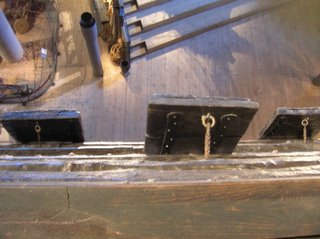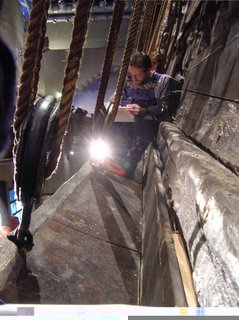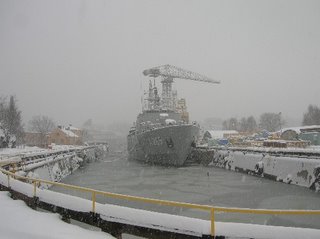 Sankt Erik in the evening
Sankt Erik in the evening
A few times in recent weeks I have had the pleasure of stepping back aboard my old floating home, the icebreaker Sankt Erik. Ole Magnus and his wife Annette have been living aboard whenever they come up from Denmark to examine, document, and analyse each one of Vasa's several hundred rope samples. Every now and then, they find some occasion to invite myself or a group of us from the museum to come aboard and join them for dinner.
It has been two long months since I moved ashore from the venerated 1915 icebreaker Sankt Erik and although my apartment is very nice and spacious, I must say I miss the old ship. I gladly would have stayed if it were possible, but even Ole and Annette are frequently punted ashore when conferences are held onboard. Luckily, however, thanks to Ole and Annette I do have these occasional opportunities to go back aboard and enjoy a lively evening on the ship.
 David (waits impatiently), Niklas (sets down the beer to consider Karl’s pontifications), and Karl (uses Finngrundet’s propeller to emphasize his point).
David (waits impatiently), Niklas (sets down the beer to consider Karl’s pontifications), and Karl (uses Finngrundet’s propeller to emphasize his point).
So, after a nice, hot, bastu (always pleasant until Karl dumps a ladle-full of water onto the hissing coals sending everybody streaking out the door to dodge the plume of searing steam), we get our winter garments on again and make our way out to the Sankt Erik. Niklas is generally in charge of provisioning the ship with a case of cold beers fetched from the carpentry shop. This doubles as a galley-warming gift for our hosts.
 Sankt Erik's green foredeck
Sankt Erik's green foredeck
It is interesting for me to go back to Sankt Erik. As soon as I step aboard she immediately feels like home again. However, as the last snow melts from her decks (I had no idea the decks were green!) and sturdy fittings and the grinding of harbor ice against the hull-plating gives way to the slap of wavelets again, I see that she has become a somewhat different place. Tourists come aboard during the day now and conferences and official parties are a regular occurrence. But enough of that, supper is about to be served…
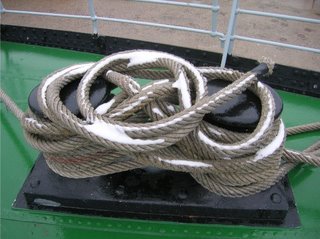 Bow bollard with the last of the winter snow.
Bow bollard with the last of the winter snow.
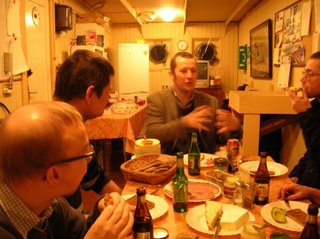 David, Ronnie, Karl, Niklas.
David, Ronnie, Karl, Niklas.Soon we are all settled in the Sankt Erik's dayroom. These people from Vasa Museet constitute some of my closest friends here in Stockholm and dining with them always makes for a delightful evening. Perhaps what makes it most enjoyable is the string of stories interlaced with intense factual and intellectual discussions that come forth during the course of the evening. No member of this group is short on great tales to tell; they are a varied, experienced, and well-travelled bunch. Amidst the clatter of dishes and animated Swedish, I can hear them warming up already, telling anecdotes and jokes.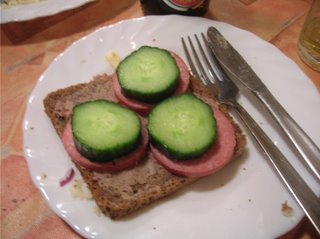 Traditional Danish brown bread meal.
Traditional Danish brown bread meal.
The Danish brown bread is passed around the table and all begin harvesting the generous spread of herring, various cheeses (usually emitting noxious gases), sliced salami, boiled liver-spread, lard, sliced cucumbers and onions, chopped pickles, bananas, and many other delicacies to be piled high upon the little square of dense bread.
 Karl, Niklas, Annette.
Karl, Niklas, Annette.
The chatter surges around the table. Then someone raises a glass with that classic Scandinavian shout, “Skål!” The conversation pauses just long enough for all to follow suit with a resounding “Skål!” and thus begins hours of eating and listening to wonderful stories. Niklas and Ronnie photo
Niklas and Ronnie photo
This group holds such a volume of amazing experiences that any evening or bastu session is guaranteed to provide an endless supply of fascinating tales and information from the lives of ‘The Bastards’ (they are the core of the group that comes to Sankt Erik). Niklas (left) is one of our great storytellers…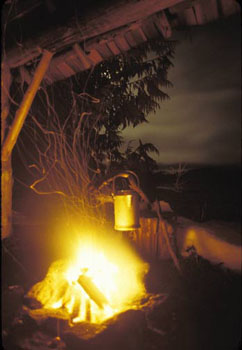 Niklas is a bit of a skogsman (woodsman) who grew up in a small timber town up north. He has great tales of his many trips into the Swedish backcountry. One of my favorites is a tale of sitting by his campfire brewing coffee in the open grasslands of the north. As he waited he saw a Sammi man (native Scandinavian nomads) come over the brow of the ridge. There he stood motionless for a while, just staring at Niklas. A little unnerved by it, Niklas simply sat there with his coffee and stared back.
Niklas is a bit of a skogsman (woodsman) who grew up in a small timber town up north. He has great tales of his many trips into the Swedish backcountry. One of my favorites is a tale of sitting by his campfire brewing coffee in the open grasslands of the north. As he waited he saw a Sammi man (native Scandinavian nomads) come over the brow of the ridge. There he stood motionless for a while, just staring at Niklas. A little unnerved by it, Niklas simply sat there with his coffee and stared back. Then the Sammi man came down to the fire and quietly seated himself on a log opposite Niklas. He then quietly reached into his reindeer-skin sack and produced a large piece of smoked meat and began to calmly slice it with his knife, all the while, eyeing Niklas’ coffee and smiling at him occasionally. Catching the man’s drift, Niklas offered to trade some of his coffee for a few slices of the reindeer meat. The Sammi man nodded gently, calmly filled a cup with coffee and handed over some of the fine reindeer meat to Niklas. When he was finished he set down the cup and without having said a word, he smiled and walked off leaving Niklas to ponder the encounter.
 David, Ole, Annette, Karl, and me.
David, Ole, Annette, Karl, and me.
Then the story telling crosses the table to Ole who regales us with his rope-making adventures in the Farao Islands. He tells of the great welcome he and Annetta received when they came to teach the islanders how to make a traditional natural fiber rope.
They were invited because the people of the islands had lost the art of doing so themselves and the loss of this art meant the potential death of one of the islands’ oldest and most cherished customs, the seabird egg feast.
 Ole overseeing a rope-walk in the Farao Islands
Ole overseeing a rope-walk in the Farao Islands
Ole helped them build a ropewalk across the grassy hills and brought them the precious hemp fiber yarns, the essential tar, and the special tools needed to lay the rope together. Nearly the entire population of two whole islands came in by boat or helicopter to participate in the event. When the rope was finished, it was carried in a long procession up into the hills and onto the high bluffs atop the towering cliffs of the island’s Atlantic side. A Farao Islander about to test Ole's rope.
A Farao Islander about to test Ole's rope.
Then, in accordance with the age-old tradition, a few carefully selected men each took a turn roping up and descending over the cliff with a bucket to collect eggs from the seabird nests on the cliff face. Dangling hundreds of feet below the bluff on Ole’s tarred, natural fiber rope, these daring lads were keeping their cultural heritage alive.
Ole recounted how that evening the islanders threw an enormous feast of the eggs, some plucked but over-cooked puffins, blood pudding, bird feet, and boiled sheep’s heads. The stench of the cuisine almost forced Ole and Annette out of the banquet hall, but to the locals it was the 'finest kind'. As Ole described the gusto with which the Farao Islanders went at these revolting dishes he had the entire dayroom on Sankt Erik roaring with laughter.  Ronnie, David, and Ole
Ronnie, David, and Ole
As Ole's profound amusement in recalling these events left him almost unable to breathe, much less speak, Ronnie (left) seized the momentary pause and launched into a bird egg story of his own. In an earlier life before Stockholm and the Vasa Museum, Ronnie was a professional seafarer. He spent nearly twenty years at sea on tankers and ro-ro’s (Roll-on/roll-off automobile carriers). 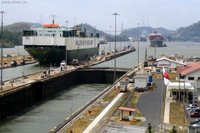 A Ro-ro like Ronnie's in the Panama Canal.
A Ro-ro like Ronnie's in the Panama Canal.
He has sailed all seven seas, traversed the equator numerous times, slipped through the Suez Canal, and squeezed through the locks in the Panama Canal. In those years Ronnie quickly rose in rank to be a senior deckhand.
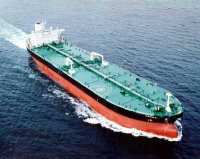 Big oil tanker
Big oil tanker
Ronnie’s bird egg story took place aboard a tanker crossing the central Pacific at a brutal 2 degrees North latitude. It was unbearably hot and somebody made a comment about frying an egg on the hatch cover. Ronnie turned the idea into a bet and pretty soon a pack of sailors, cash in hand, raided the galley for a few eggs and charged out into the searing heat on the main deck. The egg was cracked and before a minute had gone by money was changing hands as the egg whitened and solidified right there on the hatch cover. When asked the inevitable question Ronnie replied, “No. We threw it overboard. I wasn’t going to eat that with all that paint on it!”
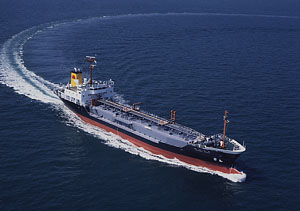 A tanker about the size of Ronnie's infamous "vinskepp" or "fun carrier."
A tanker about the size of Ronnie's infamous "vinskepp" or "fun carrier."
Niklas could not resist asking Ronnie to “tell the vinskepp story.” Ronnie grinned mischievously and launched into an even better tale of a voyage out of the Black Sea aboard a sizable coastal tanker loaded with a cargo of over 1 million litres of wine destined for a bottling plant in Sweden. Now it didn’t take us—and shouldn’t take you— long to see where Ronnie’s story was headed. It was simple arithmetic; add together a crew of over-worked sailors laboring under the hot Mediterranean sun during a two-month voyage perched on top of a veritable swimming pool of wine. You do the math.
Well, to put it simply, Ronnie told us that not all the cargo reached its destination. The ship had scarcely slipped its moorings on the Romanian coast before the maze of pipes on the tanker’s deck had become a veritable bar tap. It made the dull drudgery of painting the ship’s upper works in the hot sun all day far more tolerable as someone routinely came around with a draught of the ‘cargo.’
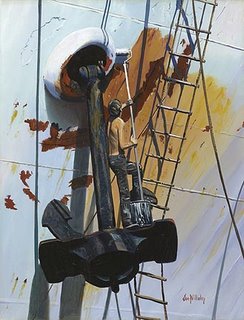 A painting of some poor schmuck painting the hull.
A painting of some poor schmuck painting the hull.
However, Ronnie, reflects, “a lot of strange things happened on that voyage. People disappeared.” Most of them vanished in port, but one chap was apparently lowered over the side in a rubber raft to paint the hull on a particularly calm day. It was painfully hot off the Sicilian coast so his shipmates kept a steady flow of wine going over the rail in buckets for the fellow down below with the paint roller. They’d send down a sample of the merlot, then some of the pinot noir followed by a bit of the sauvignon blanc. After a few hours of this, someone went to the rail to deliver him a bucket of Shiraz only to peer over the rail and see nothing but the ship’s foaming bow wave. A man-overboard alarm was sounded and the search began. It had been an hour or more since anyone had checked on the man. Soon a little yellow raft was sighted several miles astern. The ship’s boat was dispatched to rescue the wayward sailor and upon reaching him it was discovered that he was sound asleep. Apparently he had drunk himself to sleep, the towline had parted and the raft--drunken passenger and all--went drifting out upon the broad Mediterranean. Breaking into English for a minute, Ronnie smiled at me and summarized, “that ship was a…fun carrier.”
Chuckling and head-shaking goes around the table, followed by the bread.
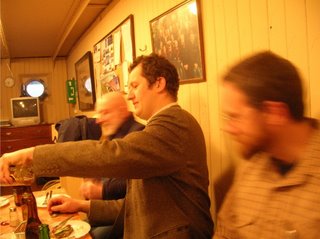 Louie, Karl, and Fred.
Louie, Karl, and Fred.Loading up another slice with salami and onions, Fred chimes in with hilarious tales of 'The Skirmishers', his little band of Virginia marksmen back home who compete in Civil War shooting competitions all over the East and South.
Fred has participated in nearly every adventurous activity under the sun (and sea) and always pursues them to a rather professional degree. He is not what you would call an 'adventure junky' craving bigger and grander experiences, he is just curious and eager to tackle interesting challenges that come his way; a true modern Renaissance man experienced and talented in everything from music to auto mechanics, diving to aviation, and archeology to marksmanship. This remarkable breadth and depth of experience enables him to offer some fantastic tales. On this occasion it would be the Skirmishers again. Like all Skirmishers tales, this one is full of gunpowder and mischief—a dangerous mix.
 This is not 'The Skirmishers' per se, but you get the idea (although 'The Skirmishers' have more composure on the firing line. They are serious marksmen).
This is not 'The Skirmishers' per se, but you get the idea (although 'The Skirmishers' have more composure on the firing line. They are serious marksmen).One of the older, crankier members of The Skirmishers is notorious for asserting his will, and as Fred's story went, on this particular occasion the group was at a local bar celebrating a unusually good day of target shooting. After a few hours this old fellow decided he wanted to go home. He ordered his buddies out but nobody seemed to hear. Fed up and no longer using the best judgement, he went out to the parking lot, unhitched the trailer carrying their huge Civil War mortar from the pickup truck, wheeled it over to the front door of the bar and loaded it with a blank powder shot. The festivities inside ended in an instant when a tremendous BOOM!! shattered the evening and accidentally blew in the door of the bar. With that, all hands complied with the order to get marching and a terrified bartender silently watched the 'Rebs' depart.
 Some of the Roskilde Viking replicas out sailing. Photo courtesy of Ole Magnus.
Some of the Roskilde Viking replicas out sailing. Photo courtesy of Ole Magnus.Sticking with the theme of bygone military forces, Ole soon picks up with a tale about sailing the Viking boats out of Roskilde, Denmark where a fleet of replicas has been built by the Roskilde Museum. Ole made the rope to almost all of these vessels and his involvement in the projects has remained high.
 Roskilde's Viking boats with a stiff breeze.
Roskilde's Viking boats with a stiff breeze.He tells stories of the invariably quirky fellows who sail these boats in the worst of conditions, often being caught in gales with novice crews or going on long-distance adventures up into the icy climes of Norway and the Farao Islands. They are often the kind of people that you think should have died before they were 25, but here they are at 60 and going strong.
 Atlantic crossing in a Viking boat--before the storm.
Atlantic crossing in a Viking boat--before the storm.Perhaps the best of them was a tale about one Viking boat that reenacted Leif Erikson's voyage to NewFoundland. The crew had been braving rough weather and cold temperatures all the way across from Ireland to Greenland and beyond, but just as they were within a few days from landfall on the North American continent, they were slammed with a hurricane. Remember, a Viking ship is an open boat without a watertight deck. The tale of their survival would be hard to believe if Ole did not have a video to show us of the harrowing event. The boat kept up a speed of 11 knots running before the wind under bare poles! 11 knots! Remarkably, they came out of it, tired and a bit ahrried, but otherwise none-the-worse. After a bit of hinting and prying, we learned that the rigging that stood up to that punishment was made by Ole's skilled hand.
 Photo from one of Fred's INA excavations in Turkey.
Photo from one of Fred's INA excavations in Turkey.Some comment about the boats' construction sparks off another discussion of vessel design that bounces around the table for a minute before settling with Fred who begins telling of what his team found during a nautical archeology excavation project in Turkey. Inevitably, the discussion entails a few tidbits from the excavation process that makes for a good story and Fred follows the thread, telling of wealthy donors hanging out at the excavation site, of novice divers getting lost and wandering all over the bottom of the bay before giving up the wreck and surfacing....again.
The tales go on and before the evening is through everyone has told a few.

We hear David's tales of being at the big game back in 19xx-whatever when in an unxpected upset Germany/Italy/Sweden managed to win/lose/get disqualified as a result of....
 David, Ronnie, Karl, and Niklas.
David, Ronnie, Karl, and Niklas.We will hear Karl's tales of sailing on Sweden's West coast, or traveling to Vancouver Canada,...
 Ole, Annette, and Louie (standing inthe back)
Ole, Annette, and Louie (standing inthe back)...or the visiting sailmaker, Louie, telling of his wild, rip-roaring, adventures in sailing races in Southeast Alaska’s narrow channels. Then it will go around again; a few more tales from Niklas about fishing and hunting trips that went hilariously awry, an administrative horror story from Fred's days teaching at Texas A&M, and so forth.
What an evening, as always....

 First of all, there is knäckebröd which is an absolute icon of Swedish culture. These are big round crackers with a hole in the middle so they can be hung over the stove and kept dry (background). I am not sure where the name comes from, but if I had to guess, it is because these rigid, almost neolithic wheels make a "knäcke" sound when you try to bite into them (okay, my Swedish dictionary translates 'knäcka' as 'to crack or break. Crispy.' Makes sense...).
First of all, there is knäckebröd which is an absolute icon of Swedish culture. These are big round crackers with a hole in the middle so they can be hung over the stove and kept dry (background). I am not sure where the name comes from, but if I had to guess, it is because these rigid, almost neolithic wheels make a "knäcke" sound when you try to bite into them (okay, my Swedish dictionary translates 'knäcka' as 'to crack or break. Crispy.' Makes sense...).
 Fish is quite common too. In fact, it is the primary source of protein in this part of the world--an interesting fact considering that the Baltic fisheries largely collapsed in the 1950s. The Soviet fisheries expansion didn't help matters.
Fish is quite common too. In fact, it is the primary source of protein in this part of the world--an interesting fact considering that the Baltic fisheries largely collapsed in the 1950s. The Soviet fisheries expansion didn't help matters.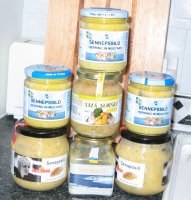 Usually you find sill in this form; packed in a jar and smothered in all kinds of exciting flavors like garlic, mustard, onion etc...
Usually you find sill in this form; packed in a jar and smothered in all kinds of exciting flavors like garlic, mustard, onion etc... But if you want your regular, meaty, semi-bovine protein source around here, you generally turn to the all-providing reindeer. You can think of them as the Buffaloes of the North. The Sami (native peoples in northern Scandinavia) seem to get everything from these animals. Indeed, Reindeer can be served in a variety of ways that the Vasa Museet cafeteria has explored thoroughly. Everything from reindeer roasts to reindeer sausages to reindeer jerky and reindeer steaks is available. My, it is good stuff....
But if you want your regular, meaty, semi-bovine protein source around here, you generally turn to the all-providing reindeer. You can think of them as the Buffaloes of the North. The Sami (native peoples in northern Scandinavia) seem to get everything from these animals. Indeed, Reindeer can be served in a variety of ways that the Vasa Museet cafeteria has explored thoroughly. Everything from reindeer roasts to reindeer sausages to reindeer jerky and reindeer steaks is available. My, it is good stuff.... Another popular Swedish dish is pytt i panne. It is the potato side of Swedish cuisine (a very large part of Swedish cuisine). It is very Midwestern at first glance...or rather, Midwestern is very Scandinavian... It is diced and fried potatoes with all kind of onions, peppars, and spices with a few eggs plopped on top to keep you warm on a winter day. The fancier the restaurant you visit, the more 'fluid' the eggs will be. I've become a big fan of this as well, though the cholesterol must be through the roof...
Another popular Swedish dish is pytt i panne. It is the potato side of Swedish cuisine (a very large part of Swedish cuisine). It is very Midwestern at first glance...or rather, Midwestern is very Scandinavian... It is diced and fried potatoes with all kind of onions, peppars, and spices with a few eggs plopped on top to keep you warm on a winter day. The fancier the restaurant you visit, the more 'fluid' the eggs will be. I've become a big fan of this as well, though the cholesterol must be through the roof...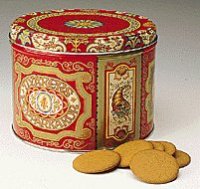 ...there are treats like pepparkakor (gingerbread cookies) that can be bought by the tin and as a rule generally form at least one large product pyramid in any grocery store...
...there are treats like pepparkakor (gingerbread cookies) that can be bought by the tin and as a rule generally form at least one large product pyramid in any grocery store...



